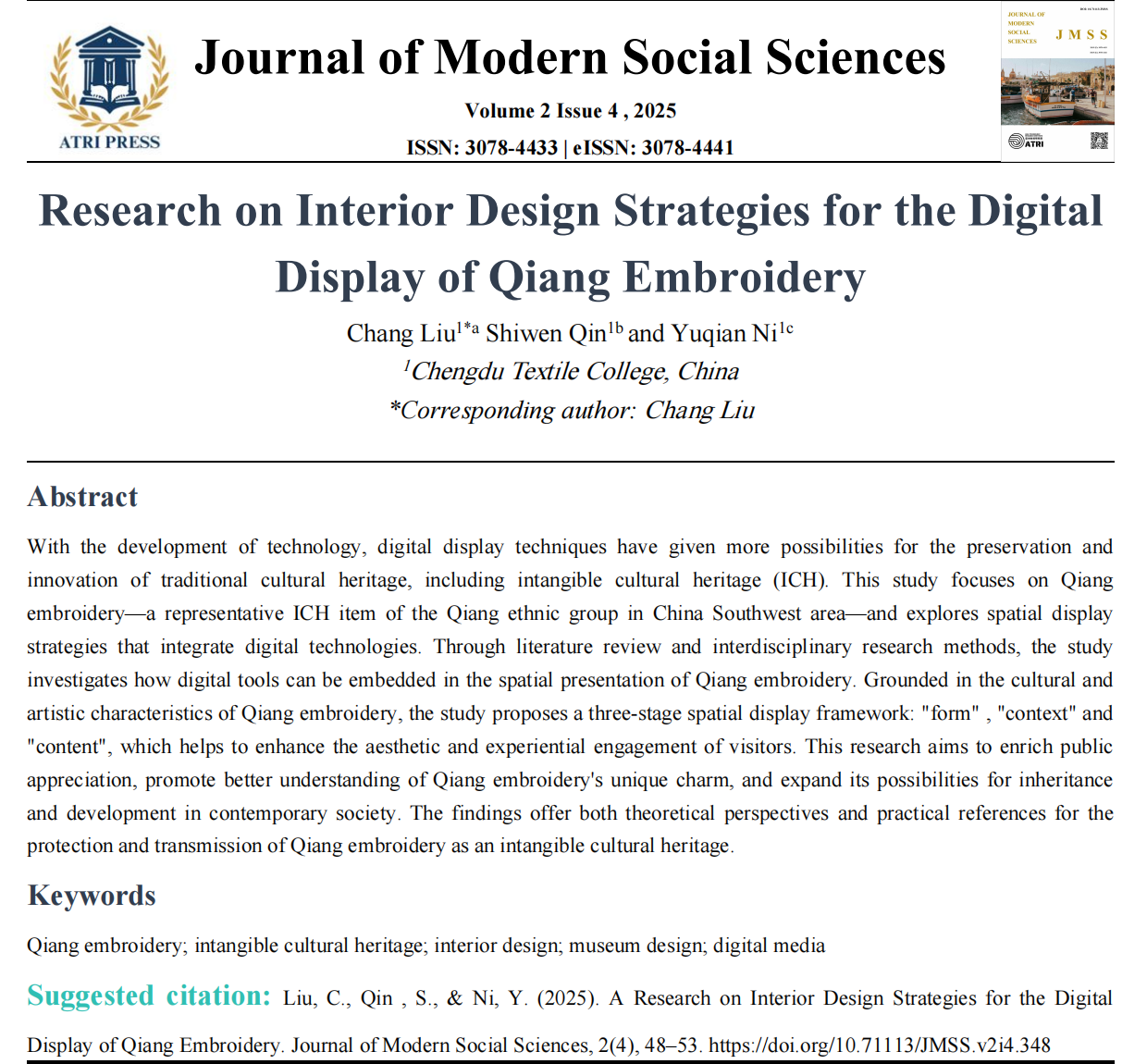Research on Interior Design Strategies for the Digital Display of Qiang Embroidery
DOI:
https://doi.org/10.71113/JMSS.v2i4.348Keywords:
Qiang embroidery, intangible cultural heritage, interior design, museum design, digital mediaAbstract
With the development of technology, digital display techniques have given more possibilities for the preservation and innovation of traditional cultural heritage, including intangible cultural heritage (ICH). This study focuses on Qiang embroidery—a representative ICH item of the Qiang ethnic group in China Southwest area—and explores spatial display strategies that integrate digital technologies. Through literature review and interdisciplinary research methods, the study investigates how digital tools can be embedded in the spatial presentation of Qiang embroidery. Grounded in the cultural and artistic characteristics of Qiang embroidery, the study proposes a three-stage spatial display framework: "form" , "context" and "content", which helps to enhance the aesthetic and experiential engagement of visitors. This research aims to enrich public appreciation, promote better understanding of Qiang embroidery's unique charm, and expand its possibilities for inheritance and development in contemporary society. The findings offer both theoretical perspectives and practical references for the protection and transmission of Qiang embroidery as an intangible cultural heritage.
References
Cao, Y. (2020). Ningqiang Qiang embroidery: A study of traditional embroidery in Ningqiang County, Shaanxi Province (Master’s thesis). Minzu University of China. doi:10.27667/d.cnki.gzymu.2020.000491.
Hao, B. (2023). Research on experiential exhibition space design of intangible cultural heritage museums (Master’s thesis). Inner Mongolia Normal University. doi:10.27230/d.cnki.gnmsu.2023.000435.
Hu, H. (2021). Intelligent recognition and digital methods of Qiang embroidery patterns and techniques (Master’s thesis). Southwest University of Science and Technology. doi:10.27415/d.cnki.gxngc.2021.000813.
Li, F. (2021). Research on narrative exhibition of intangible cultural heritage (Doctoral thesis, Chinese National Academy of Arts).
doi:10.27653/d.cnki.gzysy.2021.000009.
Li, Y. (2023). Study on digital motion graphic design of Qiang embroidery intangible cultural heritage elements (Master’s thesis). China Academy of Art. doi:10.27626/d.cnki.gzmsc.2023.000191.
Lü, J. (2021). Research and design innovation on Heihuzhai Qiang embroidery in Maoxian County from an iconographic perspective (Master’s thesis). Southwest University for Nationalities.
Ma, J. (2018). Transliteration and innovative design of Qiang embroidery patterns in Ningqiang. Packaging Engineering, 39(20), 22–28. doi:10.19554/j.cnki.1001-3563.2018.20.004.
Tong, X. (2012). Narrative space: Constructing emotional experience in exhibition space. Decoration, (10), 87–88.doi:10.16272/j.cnki.cn11-1392/j.2012.10.031.
Wang, X. (2021). Research on digital display design of intangible cultural heritage based on experience concept (Master’s thesis). Shantou University. doi:10.27295/d.cnki.gstou.2021.000589.
Xiao, Y. (2019). Virtual and real: Digital preservation and dissemination of Qiang embroidery. Art Evaluation, (15), 14–16, 133.
Zhao, X. (2012). On the Qiang people's nature worship and polytheistic beliefs. Religious Studies, (01), 233–236.
Zhong, M., Fan, X., & Fan, P. (2012). Qiang costumes and embroidery. Beijing: China Textile Press.

Downloads
Published
How to Cite
Issue
Section
License
Copyright (c) 2025 Chang Liu, Shiwen Qin , Yuqian Ni

This work is licensed under a Creative Commons Attribution 4.0 International License.


























